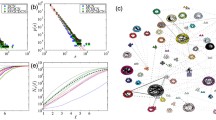Abstract
Researchers have done considerable work on the structure of social network recently, but mostly neglected the correlation between two connected nodes. In this paper, our primary goal is to acquire users’ structural properties in mobile call networks. We take a novel perspective-structure correlation between two connected users perspective to study the structural properties. To investigate the structural properties in static and dynamic mobile call networks, we define some metrics which are based on the clique size vectors of mobile call users. By exploring several real-world mobile call networks, which contain hundreds of thousands of mobile call users respectively, we find that people tend to communicate with the one who has a similar structure in static mobile call networks. Moreover, It is found that the connected people have similar structural changes on the whole in dynamicmobile call networks, and the structures of some two connected persons both have growing or shrinking trends. We use a visualization toolkit to give a view of the growing or shrinking scenarios temporally.
Similar content being viewed by others
References
Singla P, Richardson M. Yes, there is a correlation: — from social networks to personal behavior on the web. In: Proceedings of the 17th International Conference on World Wide Web, 2008, 655–664
Leskovec J, Horvitz E. Planetary-scale views on a large instantmessaging network. In: Proceedings of the 17th International Conference on World Wide Web, 2008, 915–924
Nanavati A A, Singh R, Chakraborty D, et al. Analyzing the structure and evolution of massive telecom graphs. IEEE Transactions on Knowledge and Data Engineering, 2008, 20(5): 703–718
Gonzalez M C, Hidalgo C A, Barabási A L. Understanding individual human mobility patterns. Nature, 2008, 453(7196): 779–782
Newman M E J. Assortative mixing in networks. Physical Review Letters, 2002, 89(20): 208701
Ye Q, Wu B, Wang B. Jsnva: A java straightline drawing framework for network visual analysis. In: Proceedings of the 4th International Conference on Advanced Data Mining and Applications, 2008, 667–674
Fisher D. Using egocentric networks to understand communication. IEEE Internet Computing, 2005, 9(5): 20–28
Watts D J, Strogatz S H. Collective dynamics of ’small-world’ networks. Nature, 1998, 393(6684): 440–442
Barabasi A L, Albert R. Emergence of scaling in random networks. Science, 1999, 286(5439): 509–512
Seshadri M, Machiraju S, Sridharan A, et al. Mobile call graphs: beyond power-law and lognormal distributions. In: Proceeding of the 14th ACM SIGKDD International Conference on Knowledge Discovery and Data Mining, 2008, 596–604
Jin E M, Girvan M, Newman M E J. Structure of growing social networks. Physical Review E, 2001, 64(4): 046132
Leskovec J, Backstrom L, Kumar R, et al. Microscopic evolution of social networks. In: Proceeding of the 14th ACM SIGKDD International Conference on Knowledge Discovery and Data Mining, 2008, 462–470
Dasgupta K, Singh R, Viswanathan B, et al. Social ties and their relevance to churn in mobile telecom networks. In: Proceedings of the 11th International Conference on Extending database technology, 2008, 668–677
Onnela J P, Saramaki J, Hyvonen J, et al. Structure and tie strengths in mobile communication networks. In: Proceedings of the National Academy of Sciences, 2007, 104(18): 7332–7336
Nanavati A A, Gurumurthy S, Das G, et al. On the structural properties of massive telecom call graphs: findings and implications. In: Proceedings of the 15th ACM International Conference on Information and Knowledge Management, 2006, 435–444
Mcpherson M, Lovin L S, Cook J M. Birds of a feather: Homophily in social networks. Annual Review of Sociology, 2001, 27(1): 415–444
Anagnostopoulos A, Kumar R, Mahdian M. Influence and correlation in social networks. In: Proceeding of the 14th ACM SIGKDD International Conference on Knowledge Discovery and Data Mining, 2008, 7–15
Asur S, Parthasarathy S, Ucar D. An event-based framework for characterizing the evolutionary behavior of interaction graphs. In: Proceedings of the 13th ACM SIGKDD international conference on Knowledge discovery and data mining, 2007, 913–921
O’Madadhain J, Hutchins J, Smyth P. Prediction and ranking algorithms for eventbased network data. SIGKDD Explorations Newsletter, 2005, 7(2): 23–30
Li M, Chen X, Li X, et al. The similarity metric. IEEE Transactions on Information Theory, 2004, 50(12): 3250–3264
Papadimitriou P, Dasdan A, Garcia-Molina H. Web graph similarity for anomaly detection (poster). In: Proceeding of the 17th International Conference on World Wide Web, 2008, 1167–1168
Tomita E, Tanaka A, Takahashi H. The worst-case time complexity for generating all maximal cliques. Computing and Combinatorics: 10th Annual International Conference on Computing and Combinatorics, 2006, 363(1): 28–42
Author information
Authors and Affiliations
Corresponding author
Rights and permissions
About this article
Cite this article
Wu, B., Hu, D., Ye, Q. et al. Correlation in mobile call networks from structure perspective. Front. Comput. Sci. China 3, 347–355 (2009). https://doi.org/10.1007/s11704-009-0043-1
Received:
Accepted:
Published:
Issue Date:
DOI: https://doi.org/10.1007/s11704-009-0043-1




